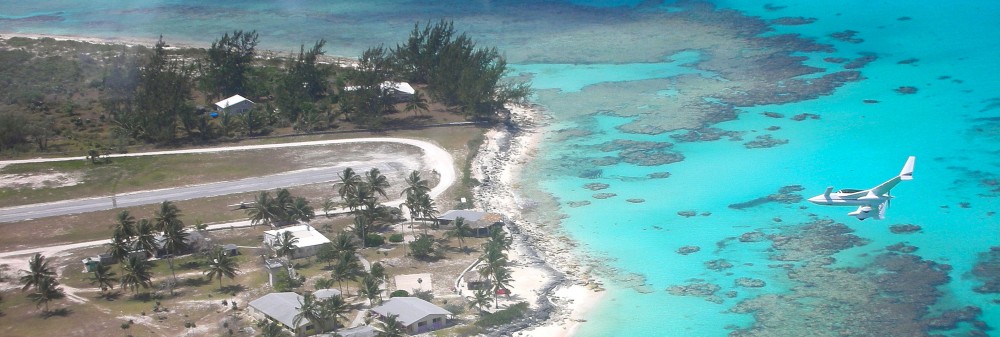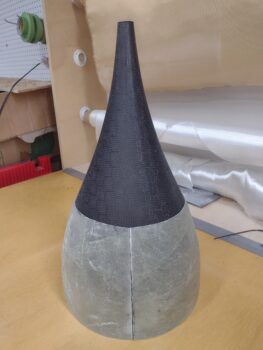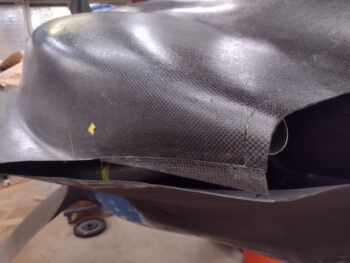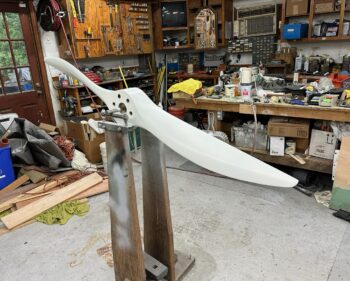I started off this morning by pulling the peel ply from the “3-ply” CF layup on the bottom aft edge of the top cowling.
I called it a 3-ply layup to make it simple in my last post, but actually only the front half of this layup, about where the sharp trailing edge terminates near the middle, has 3 full plies of CF. From that point aft there is only one ply that is fairly narrow, borders the grey tape and terminates at nearly a point at the aft end of the cowling. This is due to the narrow CF piece I added being fairly thin. That being said, there is room for one more ply to fill this remaining lower area at the aft end of the cowling.
Again, this isn’t my preferred style of cowling closeout, but I realize that A) there has to be space allowed for the exhaust pipes —and that is THE reason you have this bulbous lower cowling meeting up with the top cowling TE; and B) not only is this how Mike Melvill designed it, but going with the design seemed to be the best path of least resistance in getting these cowling installs finished. With that being said, I’ll remind everyone that this is an iterative process… mainly because I’m not only constructing the lower lip of the top cowling, but matching edge thicknesses between top and bottom cowlings as well.
I then prepped the surface on the right bottom side of the top cowling. I cut another filler piece of Lantor Soric and applied it in about the same area as on the left side. I also had a narrow (less than 1/2″) one-ply CF filler piece for the dip at the seam of the aft and middle flange layups.
With all the prerequisite tasks out of the way, I laid up 3 plies of CF butting up to the edge of the bottom cowling on the lower side (gray tape) and along the top cowling TE on the front half and the top cowl original edge on the aft half.
I then peel plied the layup. I’ll note that I used MGS 285 epoxy on this layup.
I already had a loose plan of how to layup the final plies of CF on the left bottom side of the top cowl, but that was accelerated a bit since I had some MGS 285 leftover in the cup from the right side (par usual… sigh).
My first ply on was what I discussed above, a very narrow wedge shape at the aft 8″ of the cowl, butting up against the gray tape edge and filling the area that only got one ply on the first go around. I then added a ply that butted up against the aft end of the bump created by the embedded Lantor Soric piece. This ply also butted up against the gray tape seam but was about 1/2″ shy of the sharp TE, wrapping around & upward just aft of where the TE dives into the vertical wall of the top cowl —which is clearly where the aft vertical segment begins. This ply went a good inch up above the top seam of the small added CF strip, overlapping onto the original top cowl skin.
Except for about 3″ on the very outboard side where this bottom side lip meets the wing root edge (full width CF in this area), none of the remaining plies touched the bottom side TE… yet all abutted/terminated at the gray tape seam and came up from there in stepped fashion. I didn’t need to add any more to the TE since it’s already way off balance with a low flat profile on the top, and a fat bulbous profile on the bottom. My main goal this round was to simply add thickness to the bottom edge at the seam with the bottom cowl edge to match elevation.
All above ply descriptors aside, the bottom line is that I met my design objective of having 5 CF plies on the bottom edge of the top cowl lower side meeting up at the seam with the 5-ply CF thick bottom cowl edge.
I then peel plied the left side round #2 (and very possibly final) CF layup.
Tomorrow my plan is to knock out round 2 on the right side. I may very well end up adding a ply or two of CF on the left side as filler, but beyond that it is very close to being complete. At some point I will have to hand off the final top cowl bottom side “makeover” to Mr. Micro and let him do his job too!
Pressing forward!



















































































